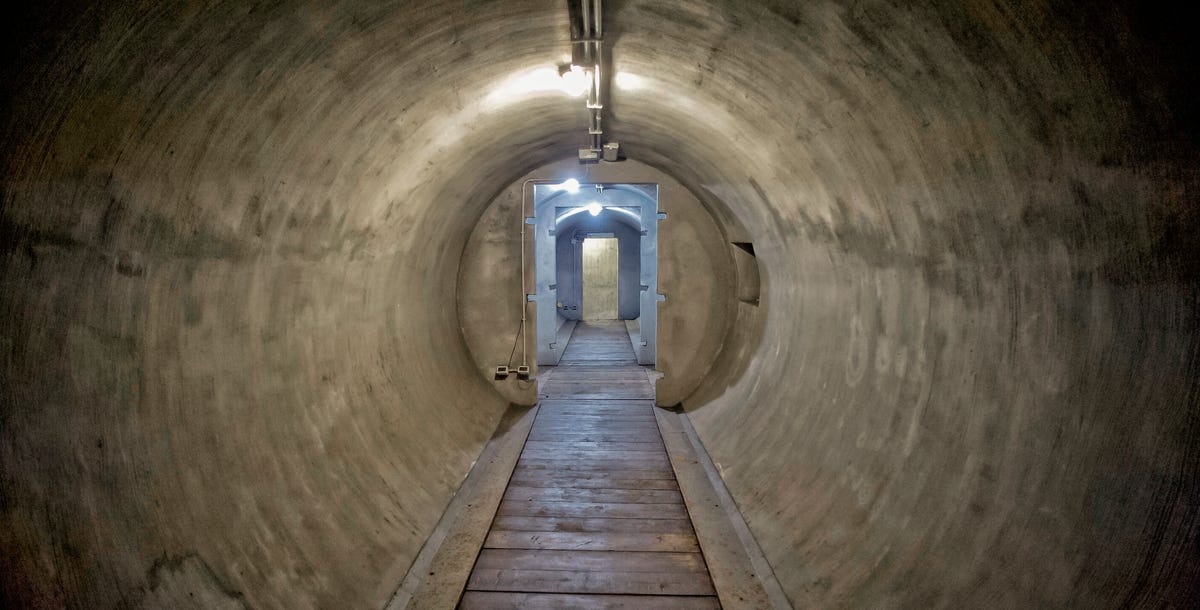Previously, a yield strength of 5,000 pounds per square inch (psi) was enough for concrete to be rated as “high strength,” with the best going up to 10,000 psi. The new UHPC can withstand 40,000 psi or more.
The greater strength is achieved by turning concrete into a composite material with the addition of steel or other fibers. These fibers hold the concrete together and prevent cracks from spreading throughout it, negating the brittleness. “Instead of getting a few large cracks in a concrete panel, you get lots of smaller cracks,” says Barnett. “The fibers give it more fracture energy.”
Holy nothing burger, Batman!
First off, this article is from 2022, re-released to farm clicks from the current hype cycle.
Secondly, this is conjecture on top of conjecture. They discuss that we can’t know the current damage from satellite, and Iran down plays the damage. Then they go on to say “concrete is strong and can be stronger”.
Articles like this annoy me. It’s all based on lots of unsubstantiated claims, and then one guy’s theoretical research. We don’t know the strength of the bombs. We don’t know the strength of Iran’s bunkers. We don’t know how much damage was done. None of this has changed. I doubt we’ll ever really know. But throw whatever political spin on it you want, and now you’ve got a click worthy news article.
There’s also the fact that the majority of Iran’s nuclear facilities were built before UHPC, the concrete discussed in the article, was available!
In the late 2000s, for instance, rumors circulated about a bunker in Iran struck by a bunker-buster bomb. The bomb had failed to penetrate—and remained embedded in—the surface of the bunker, presumably until the occupants called in a bomb-disposal team. Rather than smashing through the concrete, the bomb had been unexpectedly stopped dead. The reason was not hard to guess: Iran was a leader in the new technology of Ultra High Performance Concrete, or UHPC, and its latest concrete advancements were evidently too much for standard bunker busters.
https://en.wikipedia.org/wiki/Fordow_Fuel_Enrichment_Plant
Construction on the facility started in 2006, but the existence of the enrichment plant was only disclosed to the International Atomic Energy Agency (IAEA) by Iran on 21 September 2009,[6][7] after the site became known to Western intelligence services. Western officials strongly condemned Iran for not disclosing the site earlier;
Seems to fall into the same timeframe.
I was suspicious of that as well, but I’m not knowledgeable enough on that subject to speak on it, so didn’t include it. But I doubt any country can build that extensive of a nuclear factory in so few years.
I thought we do know the depth of the bunkers though. And that American bombs can’t go that deep, even multiple of them
I can’t speak to that aspect. But I firmly believe that if our military planned and carried out this strike, then we had very good evidence that their bunkers were at a depth these ordinance could reach.
Consider who actually makes this decision, in this case. It’s highly likely our intelligence assessment here is very accurate orr flat out denied by the dipshits actually making the call if it’s not what they want to hear.
Like they did publicly. On this conflict. To the press.
The US intelligence community kept asserting that Iran is not pursuing a nuclear weapon as late as Spring 2025.
Nothing of this was based on consistent intelligence.
Why would we bother with that level of analysis just to distract people from ICE raids?
Sounds to me like someone is trying to justify actually using a tactical, atomic bunker buster.
deleted by creator
I never really got why tactical and strategic nukes are so wildly different. Aren’t those words more or less synonyms?
deleted by creator
rest of Tokio is mostly intact
and housing becomes much more accessible too when buildings are intact but their inhabitants have much shorter lives because of radiation
deleted by creator
“Eventually” might be a long time with radiation.
20 years after the Chernobyl disaster the level of radiation was still high enough to give you a good chance of cancer if you went to live there for a few years.
https://www.chernobylgallery.com/chernobyl-disaster/radiation-levels/
I don’t know how much radiation these “tactical” weapons release, but if it’s comparable to Chernobyl, even if the buildings were not originally damaged, I don’t know how fit they would be for living after being abandoned for 30 or 40 years.
deleted by creator
The reality is that “tactical” and “strategic” are functionally meaningless adjectives when applied to weapons or systems.
Theoretically, “tactical” refers to how a military unit engages another military unit. It is how a commander wins a battle against an enemy unit.
“Strategic” refers to how a nation engages another nation. It is how a government wins a war.
The term “tactical nuke” referred to something that a lower level commander could have been authorized to use under his own judgment. If Soviet tanks were rolling across Europe during the cold war, commanders may have been granted the discretion to use small nuclear weapons to halt their advance.
Since the the doctrine of Mutually Assured Destruction was established, there has been no such thing as a “tactical” nuke. Any wartime use of a nuclear weapon of any kind demands an escalation to total annihilation. I used the term “tactical” ironically, to refer to a pre-“MAD” doctrine that can no longer exist.
In declaring that conventional bombs cannot penetrate this fixed bunker, it seems that someone is pushing for unconventional warfare. The reality is that this bunker is not impenetrable. It shares the same weakness as any bunker: getting into and out of it. Bomb the entrances to the bunker, and it will take months or years to tunnel back in. Whatever they are doing inside it, they won’t be doing until they manage to dig it up again.
Very much not.
Tactical means immediately useful. E.g. use against troops. Strategical means mediately useful. E.g. use against infrastructure and production capacity. Also massively killing civilians. This is where most heinous war crimes live.
immediately
mediately

One means directly, one means by middle man. E.g. a president is elected mediatly by electing a law giving council that then votes on who becomes president. As opposed to the people electing said president directly.
In common usage they’re equivalent to small and big. In practical terms, all nukes are strategic - use of a nuke has profound global diplomatic repercussions.
Generally yield and intention difference, strategic takes out cities, tactical takes out factories, military bases and compounds.
It is like a rifle vs. a cannon.
Yes it is functionally the same, but the “bullet” is much much larger.
Not really. More like a cannon and an artillery aimed at industrial capacity.
I suspect the world would be safer if everyone just let Trump think he won.
That’s impossible. “Make America Great Again” is a slogan that he can only abuse as long as there are problems. If he wants to stay in power it’s in his best interest to create problems. It’s what fascists dictators have been doing since forever. Even if there are no problems they will point towards something and make you think it is a problem, so they can market themselves as the solution. If he would “win” he would lose his power, which is obviously the opposite of what somebody like Trump wants.
That is depressingly insightful. See also: the internal war on everyone who isn’t a middle-aged white cis het man (and even some of them, too). Just negativity all around.
What really brings me down it’s the certainty that even if that is guy was suddenly not there anymore, there is a whole gaggle of like folk ready to continue that same rhetoric. How do you even dig yourselves out of that?
That is depressingly insightful. See also: the internal war on everyone who isn’t a middle-aged white cis het man (and even some of them, too). Just negativity all around.
Yes. Separating the people is an extremely strong tool in the authoritarian handbook. It is such a strong tool that the things it accomplishes are too much to list here. There are a lot of books on the matter. I think it’s even explained in some of the CIA books.
What really brings me down it’s the certainty that even if that is guy was suddenly not there anymore, there is a whole gaggle of like folk ready to continue that same rhetoric. How do you even dig yourselves out of that?
This is not completely correct. People fighting back against their oppressors sends an extremely strong message. And it even goes both way. For example, the attack on the USA Capitol of January 6th gave these Magazis a lot of power because they saw unity in their oppression.
The good thing is that there’s always more good people than bad.
I wonder if Hasbara accounts are pressing this narrative?
That concrete really isn’t new and really isn’t that special. There’s a reason they built it under a mountain - because the mountain does what concrete can’t.
It is not that it can do what concrete cannot. It is just that digging a tunnel under a mountain is much easier than making a mountain out of concrete.
Nothing is unbreakable.
And no bomb is irresistible.
That’s why we need the Orbital Ion Cannon.
Goddamn GDI bootlicker!
I did NOD see that coming.
You can’t win, Kane!
Sorry no tiberian. This is generals timeline. Need partical cannon.
“Hey there, you sexy bomb… I can’t stay away!”
You triggered a thought: what if those bunker busters carried a payload of corrosive material, something that the explosive event could deeply embed into the concrete, slowly degrading its strength - possibly until total failure?
What material would that be? Corrosives have limits, they can’t just keep dissolving stuff forever.
And what would “total failure” look like? It’s a mountain, it’s not going to just collapse into goo.
Corrosives have limits, they can’t just keep dissolving stuff forever.
Thus, the explosive assist for initial penetration. The type would depend on the composition of the concrete, you’d probably be more successful targeting the tension strength of the fibers or metals instead of the compression strength of the cement.
And what would “total failure” look like? It’s a mountain, it’s not going to just collapse into goo.
You don’t need goo, you just need enough weakening that it no longer supports the 250’ of loose rubble atop it and collapses into the interior space.
Coreium.
We drop an overloading nuclear reactor on top of the complex, and let the radioactive core China-Syndrome itself straight through, rendering the entire area uninhabitable for thousands of years.
Blood of xenomorphs from the Alien movies
That’s a work of fiction. You might as well suggest dropping lightsabres on the bunker.
My first thought is actually getting the corrosive substance onto enough of the concrete would be difficult, assuming they aren’t able to penetrate the concrete then they have to rely on it seeping from the ground, or if they can penetrate then the substance is only really going to be in the chamber where the buster detonated.
I have zero experience with ordnance or busting bunkers though so that’s just a shot in the dark
My first thought is actually getting the corrosive substance onto enough of the concrete would be difficult
Yeah, if the concrete is 40’ thick and they’re only getting 10’ of penetration with the explosives, then this isn’t going to do much. But if it’s 20’ thick and they got through the first 12 with HE, the remaining 8 are going to have a lot of cracks to admit slow liquid death.
I have zero information on what the reinforcers are in the concrete, so shot in the dark is about right. Glass might be tough - unless you could deliver hydrofluoric acid effectively. Metals - we’re not going to want to wait for iron to oxidize, looks like hydrogen embrittlement with HF again - so maybe that’s the magic sauce. Nasty stuff, but that’s what weapons manufacturers are good at handling and packaging: nasty stuff.
2000 lbs of HF poured on the surface isn’t going to do much to the buried chamber, but 2000 lbs of HF delivered into the freshly stressed and heavily cracked concrete layer under all the dirt - that could be a problem for future use of the facility.
Unfortunately (?) HF is a gas.
inste-edit: I know I’m being pedantic and a reasonable concentration of hydroflouric acid is what you were talking about. There was an article somewhere about a 1 tonne spill on chlorine triflouride
There was a “etch your VIN in your car window glass” campaign around here years back, they had a liquid solution of HF that they were wiping across printed stencils to do the glass etching. The fact that its natural state is a gas just makes it all the nastier to handle - and possibly even more effective at diffusing through the cracks to cause hydrogen embrittlement of any steel reinforcement it may come into contact with.
Except copeium.
Except for my spirit.
You can’t break what is already broken
Someone, somewhere, said they don’t like you.
Now CRY!
Everyone likes me.
Giving the yield strength in psi is the most pointless thing ever. Every single engineer would use metric Pa so its clearly a conversion for the average american idiot but the average American idiot has no idea what yield strength is.
We dropped a big boom worth 120000 hamburgers and the explosion was many football fields big. Salute to the brave troops.
Your comment is informative but now all I can hear in my head is Green Day’s “American Idiot”.
Sorry bud, you’re straight up wrong. Aerospace and defense in the US very much still uses the inch-pound-second system of units.
I’m not a concrete guy, but I know that metals and composites have material properties certified for use in civil and commercial aviation are given in psi in MMPDS and CMH-17. I would be willing to bet that concrete specifications in the US are no different.
I could keep going. Our bolts are specified in ultimate tensile strength by psi. Structural steel standards use minimum yield strengths in psi. There is literally a type of steel called A36 because its minimum required yield strength is 36,000 psi.
Yeah psi is a pretty common unit and trivial to swap between if SI is needed.
Arguments like above often show a lack of real world experience.
I prefer my mechanical stress calculations in millidynes per square kiloparsec thank you very much.
From this article it sounds very likely that the bunker buster attack failed.
And I read that the US used more than half of its stock of these bunker-buster bombs in this attack, the largest conventional bunker-busters in existence. So they can’t simply try again.
By your math, they absolutely can simply try again: one more time.
By my math, the bunker-buster bomb makers just got a big new contract.
something something DOGE of WAR something…
They can try one more time but worse
I mean they usually only do about 30 damage anyways.
I love how unhinged random fan wikis sound without context. Here for instance: Bunker Buster, see also: Concrete Donkey and Buffalo of Lies
I hadn’t clicked the link yet, but Concrete Donkey told me what it was immediately
So Iran knew EXACTLY how strong they needed to make their defenses!
Pretty stupid of the American military to give that info to a game developer, that would obviously use it.
The article is 3 years old
But the information still seems valid.
It’s confirming your bias so you like it…
My guess: that bunker buster attack was twice as successful as the missile attack on the the airfield in Qatar.
2 x 0 = 0.
Now accepting bets on when we will find out that Trump had a secret call with Ali Khamenei where they negotiated the whole thing ahead of time, thus explaining the movement of the Uranium out of the facility, the movement of our servicemen out of the airbase, etc. etc.
Why? The kinds of UHPC being discussed in the article weren’t available even in the United States until the year 2000 but most of Iran’s nuclear facilities were built between 1974 and 2005. Even their primary enrichment facility in Fordow, which was struck with MOPs, was started no earlier than the mid-2000s as it was still unfinished in 2009.
Basically the majority of Iran’s facilities, even their major ones, are too old to have the kind of concrete being discussed in the article.
That’s what they want you to think, but we have no evidence to either direction. And I doubt we will ever have a definitive answer.
Impressive.
“no, these missiles only bust the bunkers we tested them on.”
Basically they used pyramid age tech to outplay billions of dollars worth of weapons tech.
Hardly. Did you read the article?
The greater strength is achieved by turning concrete into a composite material with the addition of steel or other fibers.
Fiber reinforcment is thousands of years old.
Calling that pyramid age I think is a little disingenuous, they didn’t have 40,000 psi concrete back in those days.
Thats fair yeah
So I did not read the article because of a paywall I’m too lazy to circumvent right now
But from OP’s summary, the main technology they’re talking about is concrete reinforced with steel or other fibers.
And that’s definitely more advanced than “pyramid age”
But it’s also pretty much a direct descendant of mud brick reinforced with straw which humanity has been using since well before the pyramids. Same basic concept, different materials.
So yes and no.
Yes…no…maybe? I don’t know. Can you repeat the question?
Egyptians stacked blocks of stone to build the pyramids.
Roman concrete was impressively strong.
Neither of them had steel-reinforced concrete.
Neither did Gothic cathedrals, which is why they needed flying buttresses.
Reinforced concrete as we know it today is a 19th century innovation, as I understand it.
https://en.wikipedia.org/wiki/Reinforced_concrete?wprov=sfla1
Maybe the commenter was thinking of adobe.
And this tech goes way beyond merely “reinforced”.
Arguably letting a big weight fall down after being brought into the air somehow is also pyramid age tech.
These bombs are not just dead weights. These bunker busters are equipped with precision guidance and fly to and hit a person on the head if they desired. It’s also designed to deliver a huge explosion AFTER it penetrates with the kinetic impact.
It can also be set to explode right before impact, like Israel really likes to do when attaching residential high-rises, to deliver maximum destruction and death.
They mean mixing in steel dust or nylon hair?
Hard to believe this is a recent enough thought.
I doubt it’s a recent thought, knowing civil engineers, they’re absolute perverts when it comes to concrete.
IIRC this type of thing isn’t new - there was research into the possibility of making ships out of ice mixed with sawdust in WWII.
It also wasn’t and isn’t that crazy of an idea.
It’s strong AF, buoyant, and you can repair it at sea using the ocean around you.
You just need a reliable way to keep it cool.
How is the fleet holding up?
We almost made it this time!
Oh well, let’s freeze another fleet, wait for January and try again
Look up pykrete, it’s actually a really cool material
I think that was kinda the idea - war production meant steel was in great demand, and this seemed like a really cheap way to make ships. I wouldn’t want to try sailing one round the Caribbean, but they might have been okay in the north sea, for example. They didn’t work out though, can’t recall why but it’s not impossible that melting may have been a factor!
The idea was to build giant floating barges in the mid North Atlantic for sub hunting escort aircraft to refuel halfway across. The escort aircraft at the time couldn’t stay with the convoys the whole way, leaving a stretch in the mid Atlantic where they were vulnerable. An ice runway would allow aircraft to cover the convoy for the entire passage, and in the North Atlantic would last months (if not longer) before melting.
Fuel requirements could get to astounding levels, even with ambient air and water temperatures below 0C any “hot stuff” onboard (engines, lights, radios, people) would have to be offset with some kind of refrigeration system, which requires: more fuel to be burned. I’m sure you can “stay ahead of things” in some environments, but it won’t be cheap on the fuel side of things.
It has been around in some form since there has been manmade concrete.
Personally, I bought a box of chopped fibers for inclusion in a concrete project some 30 years ago - sold labeled for that specific use.
Its called FiberMesh

It’s been done in mining for decades
I asked because I’ve heard such advice for bloody countryside home floors. Not even something requiring it.
Turns out that anti-cracking tech is widely applicable, if a bit expensive.
Fiberglass, carbon fibers, or small steel wires. They don’t need to be long, the snippets are only a few centimeters in the video I have seen.
If it’s reinforced steel concrete, it would be much harder to bunker bust.
I sure would like to read this article, it seems fascinating, but it’s paywalled.
They used nagarjuna cement
I low key assume this means the next strike will be using tactical nukes. This is bad news folks.
Don’t give any voice whatsoever to the concept that nukes might possibly be acceptably used, anywhere, anytime, for any reason.
…please don’t give them ideas.
















